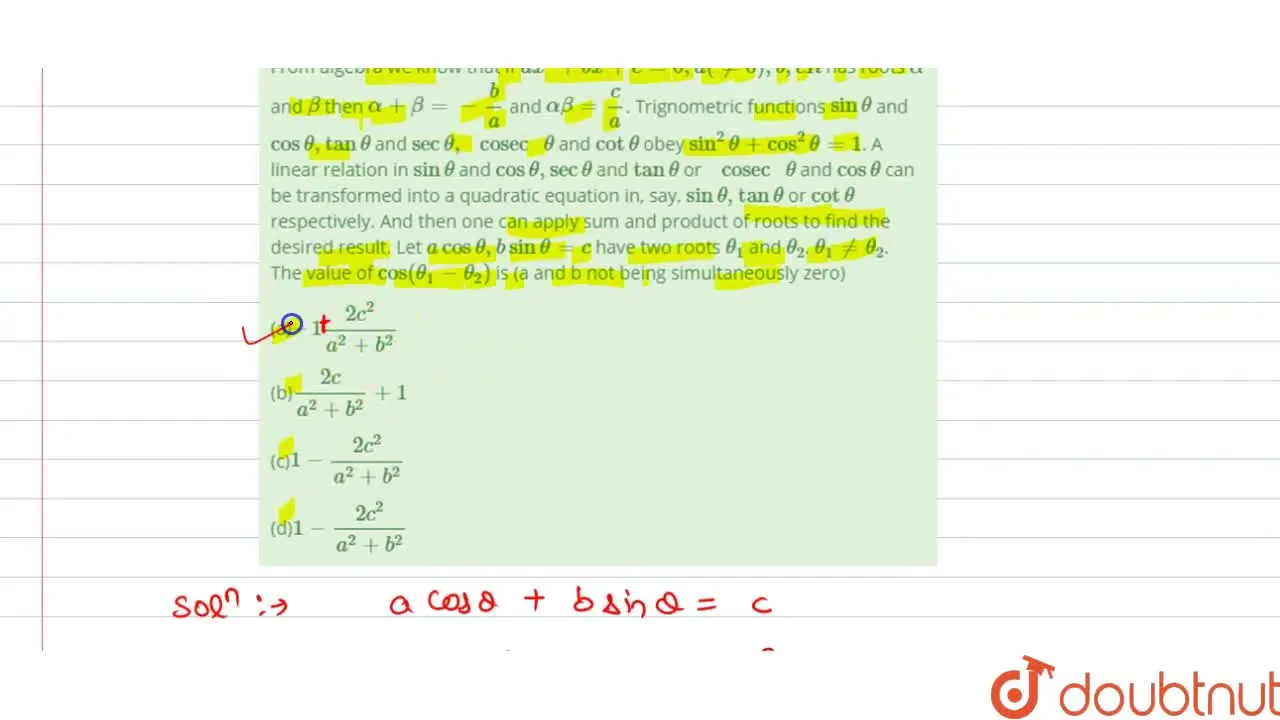From algebra we know that if ax2+bx+c=0,a(≠0),b,cR has roots α and β then α+β=−ba and αβ=ca. Trignometric functions sinθ and cosθ,tanθ and secθ, cosec θ and cotθ obey sin2θ+cos2θ=1. A linear relation in sinθ and cosθ,secθ and tanθ or cosec θ and cosθ can be transformed into a quadratic equation in, say, sinθ,tanθ or cotθ respectively. And then one can apply sum and product of roots to find the desired result. Let acosθ,bsinθ=c have two roots θ1 and θ2. θ1≠θ2.
The value of cos(θ1−θ2) is (a and b not being simultaneously zero)
(a)−12c2a2+b2
(b)2ca2+b2+1
(c)1−2c2a2+b2
(d)1−2c2a2+b2
The correct Answer is:D
Step by step video & image solution for From algebra we know that if ax^(2) +bx + c=0 , a( ne 0), b, c R has roots alpha and beta then alpha + beta=-b/a and alpha beta = c/a. Trignometric functions sin theta and cos theta, tan theta and sec theta, " cosec " theta and cot theta obey sin^(2)theta + cos^(2)theta =1. A linear relation in sin theta and cos theta, sec theta and tan theta or " cosec "theta and cos theta can be transformed into a quadratic equation in, say, sin theta, tan theta or cot theta respectively. And then one can apply sum and product of roots to find the desired result. Let a cos theta, b sintheta=c have two roots theta_(1) and theta_(2). theta_(1) ne theta_(2). The value of cos(theta_(1)-theta_(2)) is (a and b not being simultaneously zero) by Maths experts to help you in doubts & scoring excellent marks in Class 12 exams.
Related Playlists
- BOOK - AAKASH INSTITUTE ENGLISHCHAPTER - TRIGNOMETRIC FUNCTIONS EXERCISE - Section E (Assertion-Reason Types Questions)18videos
TRIGNOMETRIC FUNCTIONS
- BOOK - AAKASH INSTITUTE ENGLISHCHAPTER - TRIGNOMETRIC FUNCTIONS EXERCISE - Section F (Matrix-Match Type Questions)1videos
TRIGNOMETRIC FUNCTIONS
- BOOK - AAKASH INSTITUTE ENGLISHCHAPTER - TRIGNOMETRIC FUNCTIONS EXERCISE - Section-C (Objective Type Questions More than one options are correct )45videos
TRIGNOMETRIC FUNCTIONS
- BOOK - AAKASH INSTITUTE ENGLISHCHAPTER - THREE DIMENSIONAL GEOMETRY EXERCISE - ASSIGNMENT SECTION - J10videos
THREE DIMENSIONAL GEOMETRY
- BOOK - AAKASH INSTITUTE ENGLISHCHAPTER - VECTOR ALGEBRAEXERCISE - SECTION-J (Aakash Challengers Questions)5videos
VECTOR ALGEBRA
Similar Questions
From algebra we know that if ax2+bx+c=0,a(≠0),b,c∈R has roots α and β then α+β=−ba and αβ=ca. Trignometric functions sinθ and cosθ,tanθ and secθ, cosec θ and cotθ obey sin2θ+cos2θ=1. A linear relation in sinθ and cosθ,secθ and tanθ or cosec θ and cosθ can be transformed into a quadratic equation in, say, sinθ,tanθ or cotθ respectively. And then one can apply sum and product of roots to find the desired result. Let acosθ,bsinθ=c have two roots θ1 and θ2. θ1≠θ2.
The values of tanθ1tanθ2 is (given |b|≠|c|)View SolutionFrom algebra we know that if ax2+bx+c=0,a(≠0),b,c∫R has roots α and β then α+β=−ba and αβ=ca. Trignometric functions sinθ and cosθ,tanθ and secθ, cosec θ and cotθ obey sin2θ+cos2θ=1. A linear relation in sinθ and cosθ,secθ and tanθ or cosec θ and cosθ can be transformed into a quadratic equation in, say, sinθ,tanθ or cotθ respectively. And then one can apply sum and product of roots to find the desired result. Let acosθ,bsinθ=c have two roots θ1 and θ2. θ1≠θ2.
The vlaue of cos(θ1+θ2) is a and b not being simultaneously zero)View Solution2sinθ⋅cosθ−cosθ1−sinθ+sin2θ−cos2θ=cotθ
View SolutionProve :cosθ1+sinθ+cosθ1−sinθ=2secθ
View SolutionProve that cos2θcosecθ+sinθ=cosecθ
View SolutionIf E(θ)=[cosθsinθ−sinθcosθ] then E(α)E(β)=
View SolutionProve that :(sinθ+secθ)2+(cosθ+cosecθ)2=(1+secθcosecθ)2.
View SolutionSolve sin2θtanθ+cos2θcotθ−sin2θ=1+tanθ+cotθ
View SolutionProve that
(sinθ−cosecθ)(cosθ−secθ)=1tanθ+cotθ.View SolutionProve that secθ+tanθ−1tanθ−secθ+1=cosθ1−sinθ
View Solution


